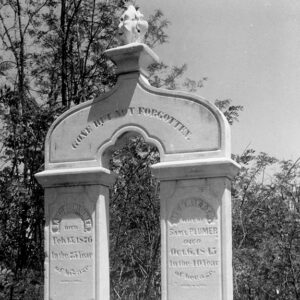calsfoundation@cals.org
Samuel Plummer (1800–1876)
By the time he was twenty-five, Samuel Plummer had finished an apprenticeship in leatherworking and subsequently traveled to Conway County in Arkansas Territory, where he bought a home and established a business location. The town of Plumerville (Conway County) grew up around his home. (His name was spelled as Plummer in most sources but was Plumer in some, and is Plumer on his gravestone; the spelling of the town’s name is based on the variant spelling.)
Samuel Plummer was born on October 3, 1800, in Alexandria, Virginia, in what is now the Washington DC area. Patrick Rodgers, a leather merchant, became Plummer’s guardian when he was seven and started him as an apprentice to learn the trade and business of leather work. After he left Washington DC, he stopped in Boston, Massachusetts, and worked for a leather merchant for a few months. He felt Boston was unhealthy, and he proceeded to Lewisburg (Conway County), today part of Morrilton (Conway County), where he began a leather business. He made saddles for Cherokee who lived in the area until they were removed in 1828 to Indian Territory (now Oklahoma). In 1828, he married Henrietta Ellis, daughter of William Ellis who had a ferry over Point Remove Creek. The sixty-foot-long ferry was used as a bridge in dry weather and a ferry when the creek was high.
Near Gap Creek on the new road from Little Rock (Pulaski County) to Fort Smith (Sebastian County), Plummer purchased the Harris farm, which included cabins, fruit trees, and cleared lands. The location was about halfway between the ferry over Cadron Creek and the Ellis ferry. The main 14′ x 14′ cabin was over time expanded to encompass several rooms, a loft, and a large fireplace and chimney. He also built a shop for his leather business.
His place became a stopping place for travelers, and he became a supplier of rations for Indians being removed to Indian Territory and sold them corn, beef, and salt and fodder for the horses and livestock. In 1831, the first group of Indians, including Choctaw Peter Pitchlyn and eighteen or twenty Choctaw with 100 horses and nine enslaved persons, traveled on the road and arrived at Plummer’s around December 20, 1831.
Between 1831 and 1838, many of the different Indian tribal groups traveling the road camped on his land. The Arkansas Gazette carried advertisements for the need for suppliers to give bids for rations for various tribes to be delivered to the groups at Plummer’s, seven miles beyond the Cadron ferry. The last was a group of 660 Cherokee with John Adair Bell as conductor and Lieutenant Edward Deas as government agent; they were at Plummer’s in December 1838.
The mail carriers and then the mail and passenger stages began regular stops at Plummer’s. A town was beginning to emerge. By 1859, he had given land for a campground to the Methodist Episcopal Church, South. In 1859, stagecoach service was sublet by John Butterfield’s company, and Plummer’s place became known as Plummer’s Station on the Butterfield Overland Mail Route. Butterfield’s service lasted only until 1861. The 1860 census lists Plummer as a farmer-saddler with $10,000 worth of real estate and $1,000 of personal property. In 1870, Plummer gave a right-a-way to the railroad over his land, and the first railroad was established from Little Rock. When the railway was completed, stagecoach service stopped. In 1872, he sold a lot for a railroad station. He made one stipulation: no whiskey by the drink would be sold there.
On October 6, 1845, his wife died. Plummer died on February 15, 1876. Eleven children were born to the couple, but only three were alive in 1876. Of those three, only two were living in Plumerville, and the other was in California. Two of his sons died in the Civil War.
For additional information:
Conway County Deeds, Book A. 323, 368, Book H. 443, Book K. 396, Book L. 488.
“Founder of Plumerville.” Arkansas Gazette, May 12, 1935, p. 38.
“Indian Rations, &c.” Arkansas Times and Advocate, December 11, 1835, p. 1.
“Little Rock Wanted the Butterfield Route.” Arkansas Democrat Sunday Magazine, September 7, 1958, pp. 5, 6.
“Plumerville Named for Early Citizen.” Arkansas Democrat, July 1, 1951, p. 65.
“Plummer’s Station.” National Register of Historic Places Nomination Form, June 10, 1975. On file at Arkansas Historical Preservation Program, Little Rock, Arkansas. Online at https://www.arkansasheritage.com/arkansas-preservation/ (accessed November 22, 2023).
Carolyn Yancey Kent
Jacksonville, Arkansas
 Business, Commerce, and Industry
Business, Commerce, and Industry Louisiana Purchase through Early Statehood, 1803 through 1860
Louisiana Purchase through Early Statehood, 1803 through 1860 Plumer Grave
Plumer Grave 




Comments
No comments on this entry yet.